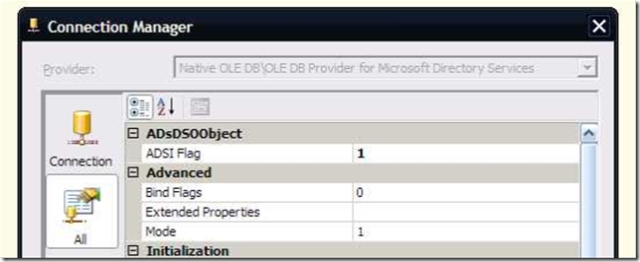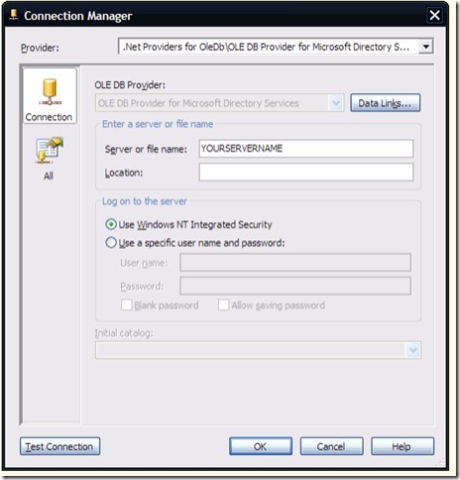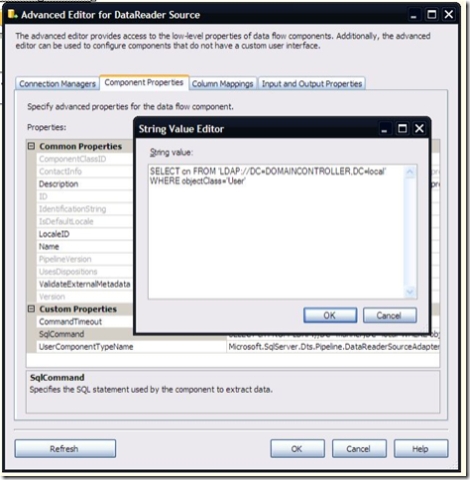I was recently asked to help someone retrieve information from Active Directory for use in SSIS. My initial thought was “This shouldn’t be too difficult. I know there is an OLE DB driver for Active Directory, so it should just be a matter of hooking up a few components.” As it turns out, it took a few hours of painful trial and error to get something working. Also, at the end of it all, I found a different approach that was as simple as I had originally envisioned it. Hopefully, this will save some time for the next person needing to do this.
I’ll start with a summary of the results, in case you don’t feel like wading through the rest. It does work, but there are a few caveats. You can use either an OLE DB connection manager, or an ADO.NET connection manager with the .NET OLE DB wrapper. I recommend the ADO.NET connection manager, as it will allow you to use access Active Directory as a source in your data flows. If you are using the OLE DB connection manager, you will be limited to using Execute SQL tasks and passing the recordset into the data flow. There is a sample package attached that shows both approaches.
I started out using an OLE DB connection manager and choose the OLE DB Provider for Microsoft Directory Services. I put in the server name, left the authentication as Windows Integrated, and clicked Test Connection. The test was successful, so I moved on to the next step.

I attempted to set up an OLE DB data source in my data flow, using my OLE DB connection manager. However, nothing worked. So I backed up, and tried an Execute SQL task. Still nothing. My first thought was that I didn’t have the syntax right for the query, but after trying it successfully outside of SSIS, I was looking at the connection again. Eventually I found a reference in MSDN to setting the ADSI Flag to 1 on the connection properties. After updating that, my Execute SQL task started working.

The Execute SQL was set up to return the full resultset to an object variable. The query used was “SELECT cn FROM ‘LDAP://DC=DOMAINCONTROLLER,DC=local’ WHERE objectClass=’User'”. This retrieves all the users from Active Directory.

I then went back to using an OLE DB Source in the data flow, but it still wouldn’t work. The OLE DB Source didn’t seem like it was able to execute the query or get any metadata from the provider. So I took the approach of using a script source to process the recordset in the data flow. (See this post for more information on handling recordsets in scripts.) That worked fine, but I was wasn’t completely satisfied.
I went back and tried creating a new connection manager. This time I used the ADO.NET connection manager, but still used the OLE DB Provider for Microsoft Directory Services through the .NET Provider for OLE DB. Just for grins, I didn’t bother setting the ADSI Flag on this connection.
 �
�
I then created an ADO.NET Reader data source in my data flow, set the connection to the connection manager I just created and put the same LDAP query in it.

When I ran the updated package, it worked first time through (without the ADSI Flag=1). Since it’s been my understanding that it is always preferable to use the OLE DB connection manager when working with OLE DB providers, this behavior was a little frustrating. It seems like you should get the same behavior whether you are using the OLE DB connection manager or the ADO.NET connection manager with the OLE DB wrapper.
Anyway, that was my journey through SSIS with Active Directory. I’d definitely recommend using the ADO.NET connection manager, as it make the process much easier. Please check out the sample package attached if you have further questions.
-
Recent Posts
Recent Comments
Archives
- January 2016
- September 2015
- August 2015
- May 2015
- April 2014
- October 2013
- April 2013
- November 2012
- February 2012
- January 2012
- December 2011
- October 2011
- September 2011
- August 2011
- July 2011
- June 2011
- May 2011
- April 2011
- March 2011
- February 2011
- January 2011
- December 2010
- November 2010
- October 2010
- September 2010
- June 2010
- May 2010
- April 2010
- March 2010
- February 2010
- January 2010
- December 2009
- November 2009
- October 2009
- September 2009
- August 2009
- July 2009
- June 2009
- May 2009
- April 2009
- March 2009
- February 2009
- January 2009
- December 2008
- November 2008
- October 2008
- September 2008
- August 2008
- July 2008
- June 2008
- May 2008
- April 2008
- March 2008
- February 2008
- January 2008
- December 2007
- November 2007
- October 2007
- September 2007
- August 2007
- July 2007
- June 2007
- May 2007
- April 2007
- March 2007
Categories
Meta
